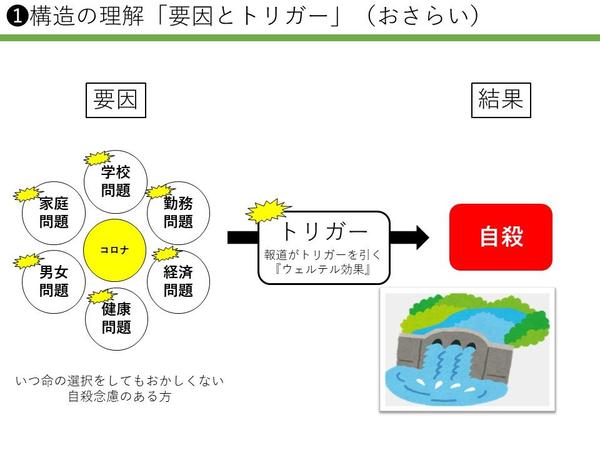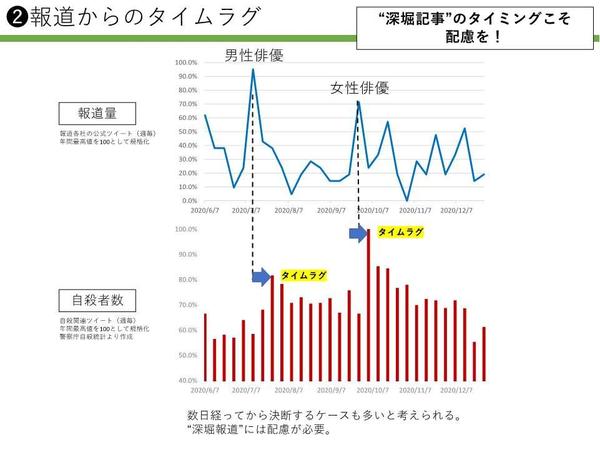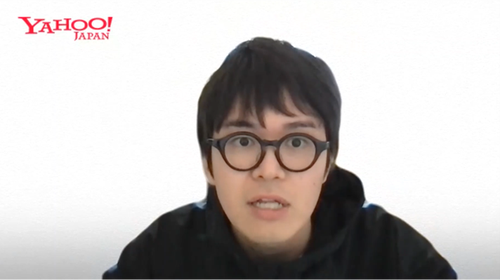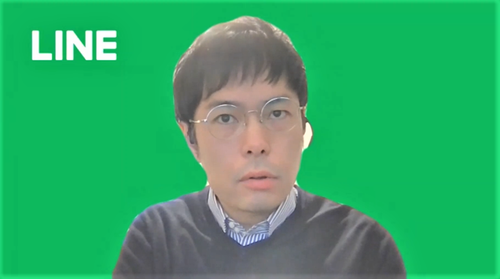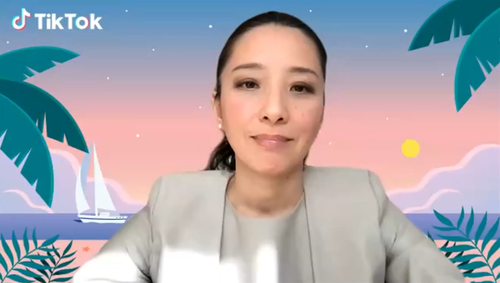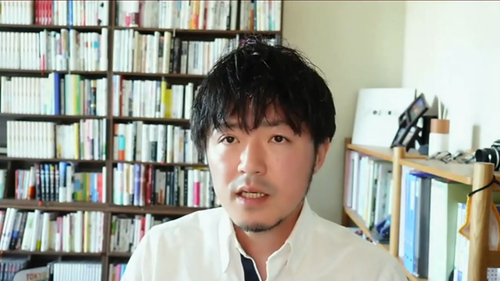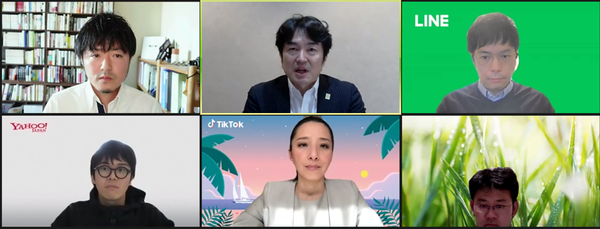

Recommendations & Raising Awareness
2nd Study Session on Suicide Coverage “Dissemination of information online and responses to it” - Report
April 28, 2022
On December 19, 2021, the Japan Suicide Countermeasures Promotion Center (JSCP) held the 2nd Study Session on Suicide Coverage “Dissemination of information online and responses to it” online. Whilst in recent years the proactive suicide countermeasures by media outlets who make news have become more widely known, the role that news aggregators and SNS platforms who gather and share information play in supporting such countermeasures is not yet recognised.
In the first half of the session, we heard reports from Yahoo! News, LINE NEWS, and TikTok, and the second half were joined by journalist Daisuke Furuta as a moderator alongside JSCP representative Yasuyuki Shimizu to discuss media and news aggregators, as well as ways to collaborate with SNS platforms amongst other topics.
To make this an open discussion where stakeholders could honestly share their opinions, this session was exclusively for target media, news aggregators, and SNS platforms. Approximately 60 people from national newspapers, TV stations, and internet media took part. (The program is available here)
(For details on the first session which looked at the initiatives of the media, please click here)
On the day of the study session, news broke of the sudden death of a female celebrity, after which there was a great amount of related reports released within a short period of time. Despite the cause of death being not yet determined, there were numerous reports referring to the possibility of suicide, or evoking the idea, and concerns about the Werther Effect (a phenomenon whereby media reports can cause an increase in suicide).
The session began at 10 am with a report by JSCP Executive Advisor Hirofumi Abe providing a collection and analysis on the various pieces of reporting on the death of the celebrity, from immediately after news broke to just prior to the start of the study session itself.
Below is an outline of the speeches by each presenter.
“How suicide reporting increases risk in the digital age” - JSCP Executive Advisor Hirofumi Abe
An analysis of reporting released on the day of the celebrity suicide
With the first report shortly after midnight last night, I’d like to speak based on the to-date and still ongoing reporting. Between the first report and now at 9 am, there have been approximately 460,000 tweets on this topic, with approximately 770 million impressions (how often this has been seen by other users). Looking through all related reporting to date, we compiled a list arranging the reporting by time, outlet, title, whether the words such as “suicide” “jumping” or “falling” were used in the title or in the article itself, and whether there was any helpline information provided for those who feel uneasy after reading the article. Based on this there are a few conclusions that can be drawn.
Point ① - Whether the words “suicide” or “jumping” were used
Although it has not yet officially been determined as a suicide, early reports in a sports journal used the words “jumping” and “thought to be suicide”. There were two sports journals (including the first) that included this information in the title, after which point the trend was seen repeated in a number of other outlets. However, even though other outlets used different phrasing such as “sudden death”, “passed away”, or “death”, the phrasing stopped at “falling”, and apparently, there were efforts to not give the impression of suicide. The number of outlets that use these words in the title are limited, and without a reporting guideline or internal rules, there is an indication that things will escalate further.
Point ② - Whether helpline information was included or not
I believe that each media outlet makes their own judgement as to whether to include helpline information in their articles for vulnerable individuals. In articles where suicide was not clearly stated, adding this kind of suicide helpline information can inversely give readers the impression that it may have been suicide. There appear to be many outlets that operated under the same impression, and articles that did not specifically state “suicide” notably did not include any suicide helpline information.
Point ③ - Whether Yahoo! and other outlets showed the news on their top page
Looking at the top pages for each outlet, Yahoo! News consistently had their reports lower down in their “Topics” section, and for NHK, Yomiuri, and Mainichi, the news was kept out of the “top stories” section. Of course, this is not to say that not reporting the news is the best option, it is still important to provide the reporting, and as such this type of consideration so that the news doesn’t stand out is excellent.
One slight surprise was Asahi, where their first report was released just after 9.30 am, more than 9 hours after the first report. This was not due to a delay in production, but rather as much as possible avoiding undue impressions about suicide as well as providing helpline information to listeners. This was an extremely considerate and well thought-out report.
On the other hand, the sports journal that released the first report had a photo of the celebrity in the thumbnail which was embedded on their top page, which would have had a strong impact on anyone looking at the site. Seeing this kind of reporting, many comments then hinted that “it may be suicide”, which in turn were made into an article by the same outlet, presenting these comments as though they were fact.
4 points to consider on the effect of reporting
As planned, I’d like to present 4 points on the influence of suicide reporting.
➊ Understanding structure - causes and triggers
Does suicide reporting induce suicide? This must be carefully considered. In statistical information provided by the National Police Agency and the Ministry of Health, Labour, and Welfare, the cause of suicide is divided into six areas: problems related to “school”, “work”, “economic situation”, “health”, “relationship”, and “family”.
The pandemic has influenced each of these causal factors, making situations worse,and increasing suicidal ideation in many people. Looking at what forms the basis, exposure to reporting on a celebrity who died by suicide for example, can lead people to think “maybe it would be easier if I died that way too”, leading the reporting to serve as the trigger. Just as rain falling on an already full dam will cause it to overflow, in circumstances whereby someone is already distressed, this kind of reporting can serve to push someone towards suicide. This is the clear image I want people to keep in mind.
➋ Differences in the compositions of the spread of “breaking news” and “deep dives”
The spread of “breaking news” refers to sharing the facts as the police understand them to press clubs, then passing the information onto larger groups of people via news platforms, starting with TV and newspapers. This spreads on smartphones instantly via push notifications, at which point the general public can then share and retweet this information with friends and family, spreading widely within a few hours.
The spread of “deep dives” is a certain amount of time after all the facts have been conveyed, and deeply investigates the various rumours, human relations, and past events. That information is then arranged and conveyed via TV, newspapers, as well as weekly journals and others, with the general public adding their voice to the story as it spreads.
Here, looking at these graphs of the reporting on the male and female celebrities who passed away in 2020, in both instances you see that after the initial burst of news, the reporting falls rapidly. This shows the initial spread of “breaking news” reporting, with the two small increases later on showing the reporting of “deep dives”.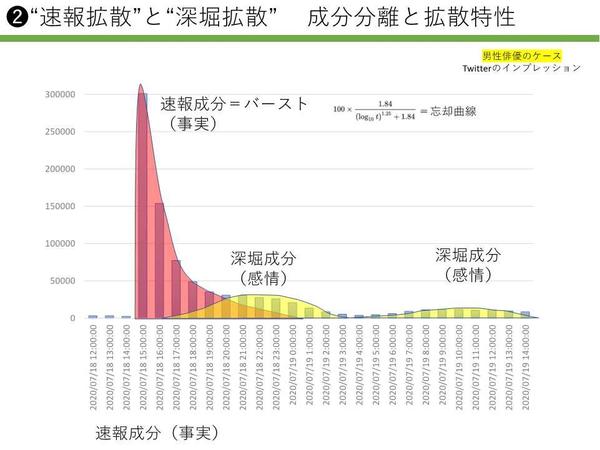
Reporting related to the male celebrity
Reporting related to the female celebrity
In the past I analysed some 35 million tweets from the Tokyo metropolitan area sent out on the day of the Great East Japan Earthquake. On this occasion, the burst of tweets focusing on the facts related to the earthquake lasted only 2 to 3 hours, whereas more emotional tweets talking about fear and uncertainty continued for weeks and months afterwards. As such, today’s first wave of reporting focusing on the facts surrounding this female celebrity is coming to a close, meaning that we can assume the emotional effects will continue from this point onwards, and we then need to think about what kind of reporting we will have from this point onwards.
Also from the reporting to arriving at the actual suicide, there is a certain amount of time in between. Looking at a graph visualising the reporting on the suicide of the male and female celebrities in 2020, we compared this below with the weekly number of suicides. Two weeks after the first reports of the male celebrity suicide, and 1-2 weeks after the female celebrity, there was a peak in the number of suicides which then subsequently plateaued. We can see from this that it’s not the initial reports, but rather the deep-diving reports that stir emotions, and after some time to think can lead to people dying. We must be vigilant around reporting for 2-3 weeks after the news first breaks.
➌ Differences between “inducing reporting” and “factual reporting”
The above graph compares the amount of suicide reporting, related social media content (tweets etc.), and the number of suicides (the gap between predicted and actual numbers) on a weekly basis. This shows that the suicide reporting and social media content following on after the deaths of the male celebrity in June and female celebrity in September dramatically increased, with subsequently then a significant rise in the number of suicides. The story with the greatest amount of reporting in 2020 was the Moritomo Gakuen scandal involving the alteration of public records, which with the timing of the legal proceedings and the release of the suicide note of the man involved, although suicide-related social media content did increase, there was not a notable increase in suicide numbers.
Additionally, when in January the Ministry of Health, Labour, and Welfare (MHLW) released the annual suicide statistics for the previous year, although there was an increase in the amount of suicide-related reporting, there was not a subsequent increase seen in social media commentary or actual suicide numbers.
From these results, we can see that even when there is an increase in suicide reporting, stories related to specific incidents, court cases, or statistics do not appear to have a significant impact on social media content or actual suicide numbers. Whereas on the other hand when the name of the deceased, how they died, or personal relatable information is reported, this may have a strong impact on social media volume and suicide numbers. With these points in mind, it would be possible to have a gentler form of reporting. It’s not at all that we should refrain from all forms of suicide reporting, but rather focus on reporting which uses the Papageno Effect to prevent further suicides.
➍ Paying attention to information lifespan
Reported news, be it article form or as video, can be subsequently picked up and sent out again by news aggregators and media companies themselves and put out on social media. Even if the original reports that the social media content is referring to is deleted, the comments of those who saw the original article are still likely to remain on social media. For example, even if the link to the original flash reports on the death of the male celebrity expires, the tweet itself remains as do the keywords in the title like “suicide” and “hanging”. As part of the design of social media, immediately below the title are options to tweet, share, and like etc., which in the case of topics such as suicide where we may not want information to spread widely, there should be debate about the purpose and meaning of adding these kinds of functions.
Update on current initiatives - Yahoo! News Takahiro Nishimura (Yahoo! Japan Corporation Executive Media Division Editorial Section)
Summary of Yahoo! News
Our operations began in 1996, and as of December 2021 we currently have 430 partner companies, and on average publish some 7500 articles a day through more than 670 mediums.
In the case of smartphones, information is arranged in 3 ways: ➊ Topics (which are edited manually), ➋ Sub-recommendations (edited partially automatically and partially by Yahoo staff), and ➌ Recommendations (edited automatically).
When publishing articles on such topics as celebrity suicide, in addition to investigating whether or not the word “suicide” is needed within the 15-character limit for titles, our staff are constantly carefully discussing the appropriate action, whilst avoiding articles that explicitly detail the location and means by which the suicide occurred, in line with the WHO Guidelines. This is also keeping sure that we are publishing articles that would not result in creating the Werther Effect.
Additionally, on the “Detailed Topics” screen which appears after tapping on an article headline, information is presented in an easy-to-understand format with the “main points” “more information” and “related information” clearly marked. In the instance of suicide reporting or articles which could possibly evoke suicidal ideations, we also provide helpline information.
The turning point for improving suicide reporting procedures
The news reporting on the suicide of a male celebrity in July 2020 was a turning point for Yahoo! News in strengthening their suicide reporting-related procedures. Initially, the first article contained the terms “suicide” and “hanging”, and there were discussions around whether this should be spread via push notifications, and whether it should be listed among the top featured articles “Topics”.
At the beginning, it was initially decided to wait until other articles which didn’t feature “suicide” or “hanging” were released, however, after an initial period no other articles were released and the first article began to spread via social media. For that reason, from a user-care point of view, under “Detailed Topics” helpline information was provided, and the first article was listed under Topics. Push notifications were then sent to users. After this, considering both the impact of the death of a young popular celebrity whilst also wanting to place importance on the very first report, articles published later which did include helpline information were later put in replacing other articles listed in the Topics section.
The suicide reporting around the death of this male celebrity ranked amongst the highest of all the traffic for Yahoo! News in 2020. Following this, JSCP released an analysis which found that subsequent suicide numbers increased, and the decision was made to make use of this opportunity to strengthen procedures around suicide reporting.
Regarding the death of the female celebrity today, just before 1.00 am this morning it was reported as “XXX fell and has been hospitalised, in a critical condition?”, which after it was found that she had passed away was changed to “died suddenly”. At this point just as helpline information was listed amongst “related topics”, reports suggesting that it may have been suicide began to be released although it had not officially been determined as such at this point. As a result, temporary banners reading “For those who find it difficult to read the news reports” were quickly put up.
Four current procedures
➊ Revising content guidelines and speaking with writers
To date, Yahoo! News had established a baseline of required considerations for writers, including such things as “does this make light of human life, or heighten the risk of suicide or self-harm?” This was subsequently updated to also include the things that should not be written on the WHO Guidelines on suicide reporting , and this was also actively communicated with content producers.
➋ Automatic provision of helpline information
As a platform (or aggregator), one measure that has been put in place is to automatically provide helpline information for readers when articles containing certain keywords are uploaded. For smartphones, between the end of the article and the comments section links are provided to helpline information under the heading “for those who are struggling”.
➌ Updating the helpline information page
The “for those who are struggling” page was updated in 2020 after the spate of celebrity suicides and subsequent reporting. Unlike the previous approach of avoiding phrases like “I want to die”, this actively removed any such taboos and made use of these phrases. Having such feelings is in itself not a bad thing, and feeling that we needed to send a message to precisely these people, we altered towards giving a clear message. We aimed to create a site that users felt comfortable with, providing a collection of different information links, a chat function at the top of the page as well as a one-touch call function. Below the helpline information we also included contents such as information about people who had overcome their own difficult times, aiming for the Papageno Effect.
After these changes were put in place, traffic to the site increased 30-40 times and the tap-rate for the chat function rose to approximately 5 times that of the call option. However, the sheer volume of usage reinforced the need to diligently address these underlying concerns.
➍ Contents making use of the Papageno Effect
Given the trend of increased suicide numbers amongst children and students after long holidays, from the end of August to September 10 2021 Yahoo! News released our own original content using the hashtag “If you’re struggling now”. This was in collaboration with Yomiuri Newspaper which used the hashtag “if you’re feeling down”, and produced around 20 articles released in the form of news bulletins. This contained things like content aimed at elementary and middle school children “Why Do I Have To Go To School?”, and articles featuring celebrities who overcame their own difficult times.
Separate from the Papageno Effect, we also had content from Yahoo! News individual authors, like articles “You Don’t Have To Watch” aimed at those who struggle with facing the sudden news of celebrity deaths, and videos aimed at people who provide support to those who are struggling.
Although we are currently putting a number of different measures in place, honestly there is still not yet an exact golden standard as to what should be done. As we continue with the measures we’ve outlined today, at the same time we want to increase our support for private organisations involved in this work.
Reporting on current initiatives - LINE NEWS Yoshio Suehiro (LINE Corporation, LINE NEWS Chief Editor)
LINE NEWS outline
LINE NEWS is a platform primarily opened as a news site on the LINE app that started operations in 2013, and has approximately 77 million monthly users. There are 3 key features of the service: ➊ Notifications screen, ➋ Output-focused, and ➌ How information is shared.
➊ Notifications screen
The main screen (top page) of LINE NEWS is what you see when you click on the “News” tab in the LINE app on a smartphone. This page has the most users and serves as an overall portal with information on sports, entertainment, dining, weather, and traffic.
In addition to this, there is the officially operated LINE NEWS account, which you can register as one of your LINE contacts. This account sends three daily updates with summaries of the day's news, as well as a special “Extra Edition” in the event of major breaking news.
➋ Output focused
The articles published on the official LINE account under LINE NEWS are picked up by the editorial division, however editing rights are also released to contracted media outlets under the LINE Account Media system. With more than 370 different mediums including newspapers, wire services, TV news, and web news, LINE NEWS has a cumulative total of 250 million users. LINE also then can select from the top news of each media outlet and choose which to send as an “Extra Edition” to users.
➌ How information is shared
On the LINE NEWS home page, there is both the recommended column of AI-selected news chosen to match each users’ individual interests (shown at the top of the page with a photo), and news manually chosen by the editorial division for users to read (below the news with a photo are the top three headlines plus one more news article with photo).
Initiatives to suicide reporting
Within the WHO Guidelines are “Quick References” which contain “must do” and “must avoid” items, upon which the overall LINE NEWS suicide reporting strategy is built. Broadly speaking the countermeasures consist of ➊ not proactively/directly reporting on suicide, and ➋ providing helpline information.
As a general rule, whilst the policy is to not specifically write about suicide, in instances where suicide reporting is warranted, the top page is what the greatest number of users see, and as such we take care to not explicitly say “suicide” but rather use “passed away” or other alternate phrases instead.
For delivery, as users receive push notifications passively rather than requesting them, we operate whereby notifications aren’t sent for suicide-related news. In the particular case of LINE, as this information can unwittingly come into conversations between friends and subsequently exert quite a strong influence, we take particular care on this point.
For expressions, as per the WHO Guidelines, we avoid any discussion of the means or location as well as sensationalised headlines. As we are a platform, we can look at articles provided by a number of media outlets and choose to display the articles deemed most appropriate.
On our platform, we are limited to just modifying headlines and certain phrases, as such we have guidelines set for media partners, and maintain open communication where we introduce the WHO Guidelines and consult where necessary.
Even in the realm of articles chosen by AI for users based on their interests, we have put in measures whereby articles that include the phrases “suicide” or “jumping off” for example are automatically not shown to users. For sensitive suicide-related articles, these are shown on the basis of having first passed a rigorous check.
For helpline information, when articles that contain the words “suicide” are automatically detected and links and banners to helpline information are set to display, and the linked pages from the banners are constantly updated by the editorial division.
Issues we’ve found
Lastly is an issue we have found regarding the provision of helpline information. In addition to us providing this information, each individual media outlet is also proactively working on this issue, however within the editorial division we are discussing as to whether this information is truly reaching users, and comments have been made about whether just providing this supplementary information is sufficient, questioning whether there could be a better way.
Also as editorial rights are partially released to individual media outlets under LINE Account Media, each individual company has their own varying editorial direction, making it difficult for us to create one standardised set of rules. What does it mean to provide information with consideration of user’s feelings? Whilst there are a number of issues, as we discuss these challenges with media outlets, we’re thinking about whether there are areas for greater levels of precision.
Regarding the female celebrity’s death today, we have carefully responded by sticking fundamentally to the basic fact that she has passed away. As this is an evolving situation, the editorial division is continuing discussions as they look into both timing and ways of displaying the information.
Reporting on current initiatives - TikTok Yoko Kaneko (TikTok Japan, Public Affairs Division, Public Affairs Manager)
TikTok is a platform where users post their own videos, and the managing team doesn’t broadcast any news, or select pieces to show to a wider audience. As such, although we are different from the previous two speakers, as a video platform I’d like to speak about how we’re working to protect users from a suicide prevention standpoint, the development of suicide prevention features, and our outreach activities.
TikTok and its features
TikTok is a mobile-centric short-movie platform operating in 150 countries and regions around the world, with a total of 3 billion downloads to date. In the beginning many had the image of TikTok being centerd around young girls dancing, however now there is a wide variety of posted content including culture, education, technology, and How-To videos among others. Government agencies and municipalities use the platform to share information as well, and many media outlets have made accounts to broadcast news. In this way TikTok can be considered as a platform positioning itself to deliver news to young people who don’t watch TV. Regarding the videos posted by media outlets, TikTok doesn’t examine these videos and gives full editorial rights to individual posters, posting the videos as is.
Although compared to other apps TikTok is, in the words of the users, “super easy to go viral and get new followers”, there is a difference in the algorithm. Whereas other SNS platforms have algorithms that only share content with your followers, on TikTok even with zero followers all posts are always shown to a certain number of people, at which point the recommended video systems judge user engagement and viewing, and then show the video to other users. As a result, videos that have good reactions and ratings, even when made by users who’ve just started, can reach a wide audience.
One other feature is that only videos can be posted on TikTok. Unlike text-only posts, videos take time to make, meaning that it’s more difficult to impulsively post out of anger. In addition, external news can’t be shared on TikTok. Selecting the “share” button on a video on TikTok will share it with other SNS platforms, however it is designed that content from other platforms can’t be shared on TikTok. As a result, even with suicide-related news, an increase in views (not the number of times shared) leads to the AI judging the engagement to be of high utility and showing the video to a larger audience. As TikTok is completely uninvolved in the details of the reported news, we leave the decision of which news to spread or not to media outlets, and instead think we can focus on spreading positive information (such as that with a suicide prevention message).
Safety and security measures
TikTok’s top priority is ensuring an environment where users can safely enjoy the app. I would like to introduce the overall measures TikTok has in place to ensure this.
➊ Rule setting
The Community Guidelines provides a compiled list of rules around which kinds of videos cannot be posted. Among this is included points on suicide, self-harm, and disordered eating, as well as clearly prohibiting videos which can potentially mimic, promote, or beautify those behaviours. Based on these rules there is technology-led detection and human-led examinations of certain videos.
These videos are checked by a specialist team 24/7, dangerous videos are flagged and reported to the police, partner NPOs are contacted and can make comments, and we also receive advice about our responses.
➋ Providing tools
As defamatory comments can be one of the causes of suicide, in 2021 we introduced the “Rethink” function for comments. When a user is about to post an inappropriate comment, the AI detects this and a message is displayed “Do you really want to post this?”, forcing the user to reconsider their comment. This has been extremely effective, effective in more than 40% of cases globally, with Japan having higher rate.
➌ Promoting education
We also promote educational materials, as well as the making of educational content and suicide prevention week campaigns.
➍ Promoting safety-related partnerships
We established the Safety Partners Council, where suicide countermeasure-related organizations such as FIND (Federation of Inochi no Denwa) and Tokyo Suicide Prevention Center provide us with advice about our initiatives.
Suicide countermeasure initiatives
Here I’d like to introduce some of the specific measures we’ve put in place related to suicide reporting.
In the search bar in TikTok, if you search for terms like “suicide”, “I want to die”, or “wrist-cutting”, videos related to this aren’t displayed, and instead helpline information will be shown. After this, a message saying “this content may be inappropriate for some viewers” is shown, after which if users then press on “see results”, they will finally see the first video. However the videos shown at this point are not just any video with the relevant hashtags attached, but are videos in accordance with our internal guidelines established in collaboration with suicide experts, and are deemed to be of use to those with suicidal ideations.
In terms of outreach, during Suicide Prevention Week in September 2020, we partnered with JSCP for example to create a page with the theme “Ask Us” within the app, where users with unresolved worries could access helpline information, as well as posting videos explaining what it’s look to actually try reaching out for support in times of need.
In Suicide Prevention Week 2021, using the hashtag #thinkingoflivingwithyou, we launched a project using the Papageno Effect, where we showcased messages from those who previously had had suicidal thoughts but had overcome them. This ranged from people working to support those in need to popular TikTokers speaking about their own experiences and how they found their own authentic way of living. These videos were very popular among users of the same age, and in the comment section were many users who were able to share, support, and sympathise with one another.
Depending on the app, in any given comment section there can be a lot of negative comments, however on TikTok, there are a lot of warm comments and sympathetic voices saying “this has given me courage” and “Life is tough for me too”. Whilst we don’t know why this is unique to TikTok, we do plan to make use of this feature in the future.
Lastly, I’d like to introduce some of the initiatives by media outlet accounts. On TBS’s news23 account, they posted a video of one of their female newscasters speaking about her experience overcoming bullying as part of their special on “For children struggling after the summer holidays”. In addition to the goal of reducing diffusion, this was introduced as an example of the kinds of positive outputs that can be done.
Points for discussion to be discussed - Daisuke Furuta (Journalist)
To reconfirm the flow for reporting and diffusing suicide reporting, the following was decided. This is based on mass media being the starting point of incident (suicide) reporting.
◆ Incident occurs
● Notification from police/fire department/emergency services etc.
↓
● TV/newspaper journalists are notified (e.g. police press club) → Breaking news
↓
● Breaking news goes to large aggregators → Reach expands
↓
● Breaking news is shared on the social media accounts of individual outlets → shares increase
↓
● Original news is referenced on secondary websites and articles based on rumours start to appear → start of misinformation
One focus of today’s discussion is the role of the expanded reach of large aggregators, and mass dispersion via social media. The question is what role do these platforms serve exactly? For many at newspapers and TV stations, the division isn’t necessarily very clear.
To introduce one way in which news is categorised, news aggregators will gather news from publishers (e.g. mass media) and publish them, which in turn has overwhelmingly strong reach (e.g. Yahoo! News, LINE NEWS, SmartNews etc.).
For social media, on the other hand, information is spread by individual and media accounts on the platform, and is interactive in nature, and has great capacity for wide diffusion (e.g. Facebook and Twitter etc. This is also true of LINE media accounts). As a video platform, how TikTok is categorised can vary, but through user interaction information posted by anyone can be widely dispersed, and as a result can be considered social media in a broader sense of the term.
Newspapers, TV stations, and magazines are publishers, and as publishers they have the capacity to control content production.
- News aggregator: overwhelmingly strong reach
- Social media: overwhelmingly strong diffusion
- Publishers: content creation
One thing to pay particular attention to is that whilst publishers have content creation, unlike the other two publishers don’t have the “overwhelming” capacity that the others do. The reason for this is that some content is made on the platform, and the amount of this individually-made content is rapidly increasing. With this understanding of the rapidly changing media environment, we need to think about how information and news are spread, including suicide reporting.
Discussion
Moderator: Daisuke Furuta
Panellists: Nishimaru, Suehiro, Kaneko, Abe, Shimizu
Responding to articles in violation of the WHO guidelines
Furuta: The first question I’d like to ask is, when there is an article reporting on suicide that doesn’t follow the WHO guidelines, what measures exactly would you take?
Nishimaru: In Yahoo! News we have staff members responsible for communicating with individual publishers, so in the event of such articles the responsible staff member would reach out to the publisher, in many cases communicating “please consider the guidelines we have in place”. Since 2020 after a series of suicide reports, we have maintained ongoing communication, and at a glance, compared with last year there appears to have been a dramatic improvement. In particular, in not using the word “suicide” and providing helpline information, I feel that there has been a significant improvement by publishers.
Suehiro: For LINE NEWS, in the short term we immediately remove the article from the recommendations column generated according to personal interests. In the medium term, similar to Yahoo! News, we communicate with media outlets and explain our intentions.
Furuta: For Shimizu and Abe, I’d like to ask what you think about these changes. Something I felt listening to holding a study session on the digitisation of news media is that people who are interested in this topic are attending, however the problem is those who aren’t in attendance. What do you think should be done to spread this information further?
Shimizu: I’ve been involved in the issue of suicide for nearly 20 years, but I haven’t seen as much change in suicide reporting as I have in the last 12 months. That being said, there are still issues with reporting going against or ignoring guidelines, and it has become particularly clear where these problems are occurring. Moving forward I think firstly we need to have the many media outlets change the overall way in which they report information, then for us here when we feel that an outlet is continually releasing inappropriate pieces of suicide reporting, we should individually approach them to discuss.
Abe: We’ve developed the “Whale Suicide Reporting Platform”, which is an AI system that detects suicide risk, however, there’s a large miscalculation here. In today’s reporting we’ve seen that the media was very diligent and most agencies reported the story without using the word “suicide”. Which is to say that whilst we have this great news that the filter words have changed, from the morning there’s been a rapid increase in the usage of the phrase “I want to die”. So even if the word “suicide” isn’t used in reporting, there is still a possibility of elevating the risk for people who feel that they want to die, meaning that there is a need to expand to other words beyond just “suicide”.
One other point is that reporting on this incident has shown polarisation in approaches. On the one hand whilst the number of media outlets putting due consideration into their reporting has increased, there are also outlets going too far and escalating things. Even if we here are moving the discussion forward with a high degree of ethical concern, there are also companies who, through their own internal corporate culture, don't have a defined set of rules. As such, there is a need to convey the true power of suicide reporting (and the effect it has on suicidal ideation).
On measures to maintain order in the comments section
Furuta: One comment we received earlier from participants regarding the comments section: “it appears that negative sentiment can really gather in the comments section”, however in Kaneko-san’s talk you mentioned that on TikTok the trend was towards much warmer, more positive comments. Ten years ago for example it was said that “Twitter is peaceful”, the reason being that if you were slanderous towards someone with an account tied to you, your own reputation would suffer. Twitter was seriously described as “a platform that doesn’t blow up”. Today you mentioned TikTok introducing the Rethink function which shows users a message asking if they truly want to post an inappropriate comment, designed to prevent conflict, which amazingly has since resulted globally in a more than 40% reduction in posting such comments. Moving forward, how do you intend to further strengthen these kinds of measures?
Kaneko: We are considering it. Other than Rethink, there’s another basic feature which allows posters to delete individually or all together all the comments on a video. There is also a comment filter feature, one of which automatically stops displaying slanderous inappropriate comments, another which doesn’t display keywords as indicated and set by the user themselves. What comments to the users themselves want to be exposed to? We’ve made this a choice that can be made by each individual user, and I think we need to create an environment where users can manage their own outputs.
Internal education/human resource training on suicide reporting
Furuta: One question we received earlier from the audience “There’s a need for training within media companies as to how to respond to the issue of suicide reporting, what kind of education or training is taking place?”. What can you tell us about this?
Nishimaru: Firstly, on an ongoing basis we invite guest speakers working on suicide countermeasures, like Shimizu-san, to speak at training sessions for employees. In addition to this, after a major piece of suicide reporting has quieted down, within Yahoo! News we hold reporting sessions where we look at what went well, as well as which parts we should continue and which parts we should improve.
Furuta: I think most TV and newspaper outlets don’t have the kinds of post-facto reporting sessions that Nishimaru-san is talking about after a major piece of suicide reporting. During these sessions, who leads and how is it conducted?
Nishimaru: There isn't a specific rule as to who leads, however typically it’s led by whoever took responsibility for the first breaking news report. As we operate on a 24-hour timescale, it’s very difficult to create a time when all of the relevant staff can attend, so we use a variety of web-based tools where each staff member can write their thoughts, based upon which we then set a time for reflecting and reporting.
Suehiro: In LINE NEWS as well we also hold similar study/reporting sessions, where we look at why a certain piece of news was chosen to be picked up, whether it did or didn’t go well after being picked up, and what to do moving forward. As much as possible we try to make the discussion process visible, so we leave a chat log of everyone’s comments, and we have a system whereby anyone who looks at the log would be about to make the same judgement. That discussion is also then put into our operational guidelines.
On “waiting” for articles with less information
Furuta: Something that surprised me during Yahoo! News’ presentation earlier was that during the reporting on the male celebrity who died (July 2020), the first report you received mentioned the phrase “hanging”, at which point you then decided to wait for an article with less information. Could you tell us a bit more about the discussion at that time?
Nishimaru: As you mentioned, the first article that arrived had a deeper level of reporting than others, and among the Topics team there was a discussion about how this article stands up in comparison to the WHO Suicide Reporting Guidelines. It was decided that we couldn’t overlook the huge influence of their passing, and the decision was made to “wait” for another article.
Shimizu: I’d like to add two points. Firstly, whilst Yahoo! News and LINE NEWS have countermeasures in place through both human intervention and AI filters, they’ve also created a method for contacting them in the event that we see an article we think could be dangerous. In this particular instance, we contacted them in this way. That being said, that’s not to say the framework is perfectly built as we are fundamentally checking on minute-level things that are out of our control, and I want to consult with the platforms about building a proper framework.
The other point is that whilst there has been great progress in displaying helpline information alongside articles, the reality is that the supporting organizations don’t always have the capacity to respond and people reaching out to those contacts don’t get any support. This is a problem that lies with the private support organizations, however at the same time as solving this capacity issue, if Organization A, for example is out of order but Organization B isn’t, is there a way to show preference for displaying the contact information of Organization B? As we bring these private organizations into line together, this is a topic that I’d like to further explore.
Continued - Internal education/human resource training on suicide reporting
Furuta: Going back to a previous question, we discussed what kind of internal human resource training was taking place on the topic of suicide countermeasures, and I’d like to slightly change the question for Kaneko-san. As a global company TikTok would have a certain level of standardization globally around the measures it takes, but is there a discussion around Japan-specific countermeasures?
Kaneko: Globally and including management, I think TikTok places great importance on ensuring our work fits the local culture of each country. Although the community guidelines are very consistent globally, things like Suicide Prevention Week in Japan are solely done by the Japan office.
Furuta: For suicide-related articles, in order to avoid the Werther Effect each company has their own algorithms and filters in place that they use to avoid giving too much information to a particular person. For platforms, these algorithms are an important tool, and closely linked to income. From an income perspective, these initiatives go against the income imperative, at what level are decisions about this made?
Suehiro: In the case of LINE NEWS, it’s common that members of the editorial division, who are looking at the content every day, come across an issue which is then investigated by a wide range of stakeholders including those with final approval authority, at which point a decision is made and implemented. It’s not the case that the most senior person unilaterally decides, but rather that everyone looks into it, and collectively makes a judgement, at which point the algorithm is then modified.
Nishimaru: Yahoo! News is much the same as LINE NEWS. I think everyone internally understands that for a sensitive issue like suicide reporting, this needs to be thought of separately from any considerations of sales and profit.
Kaneko: For TikTok, in addition to measures like deleting videos which violate the community guidelines, we also ensure that the algorithm and recommended videos don’t concentrate too much of a given content on people. In fact, another way of looking at it is that if a user is recommended many videos that are all similar to each other, is this actually a good user experience?
Furuta: Lastly, we have many publishers here in attendance today. What do you think are the areas where publishers and platforms can collaborate together? Also, there are some here asking for advice, what advice would you give?
Nishimaru: To date, we’ve communicated and had a great level of cooperation with those in the media, but if we’re to think more expansively, I think together we can build a system whereby publishers, in keeping with the on-site facts of the matter, make use of their capacity to make fantastic content, and release articles that also care for those who are affected by the reporting. One difference between paper-based media is that online articles can be changed even after they’re released. If a certain phrase seems off, or if helpline information is missing, this can be added later on. Whilst there are many ways to approach the issue, I think reporting which involves human life should always be under consideration.
Suehiro: Currently articles are published at the speed of the platforms, and articles tend to be tied to how easy they are to publish. However, for LINE NEWS, we want to spread to a wider audience fully fleshed out articles. Rather than just focusing on speed, we want to focus on spreading quality content.
Kaneko: Besides from suicide reporting, sharing the stories of those who have overcome suicidal thoughts is also important. If suicide reporting is to spread, I think it would be good to have the stories of those who’ve overcome their difficulties to spread just as much.
Furuta: I’d like to summarise some of today’s discussion. For myself, today’s presentations have been extremely informative, and I think we’ve been surprised at the extent of the initiatives and countermeasures put in place by not only publishers but platforms as well. Particularly of note are initiatives like Yahoo! News and LINE NEWS ensuring proper feedback from the frontlines and then reflecting them internally, as well as TikTok having Japan-specific measures in place rather than one standardised global response. As these spread, I believe reporting itself will also change, and over the course of the last year and several years, we’ve already seen a great amount of change in suicide reporting.
I think this is due to the publishers here today each individually raising their voices. The next step is to spread to those who aren’t in attendance today, and I think there’s a need for more study sessions like today which transcend any one individual agency. For the things that don’t change at that point, individual consultation will be the next step. In this way, I think we can sketch out the way in which the whole can improve.
Closing Remarks - Shimizu Yasuyuki JSCP Representative Director
Once again I’d like to thank everyone who spoke here today. JSCP intends to continue to work in a variety of ways on reporting that contribute to suicide countermeasures. In this, not necessarily every media outlet will be reporting based on the WHO Guidelines, and whilst these companies may have reasons for doing so, I intend to reach out to them individually. As we continue our discussions in the future, I encourage all of you to join me on this journey.
As Abe-san mentioned in his opening remarks, following on from a piece of suicide reporting, immediately afterwards the risk of suicide is elevated, and when two celebrities passed away in 2020, the number of suicides increased for about two weeks after the news broke. For today’s case (the news of the female celebrity who died), the cause of death is as of yet undetermined, but we are in the midst of an elevated risk of suicide right now. For those people who are just hanging on, will they be pushed towards suicide, or will they be pushed towards life. There are many things we can do. Hold onto that nervousness, and together we can continue our work.
Related New Topics
- November 28, 2025
- Call for papers : Suicide Policy Research (Volume 5, No. 1)
- October 9, 2025
- JSCP’s Online e-learning Training Program to Promote Suicide Countermeasures at Universities
- September 18, 2025
- Suicide Policy Research





